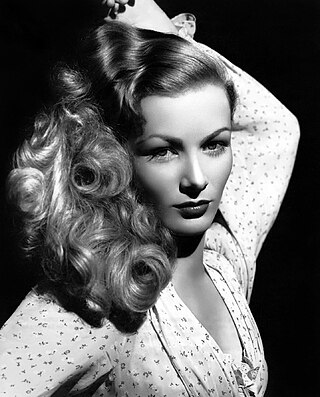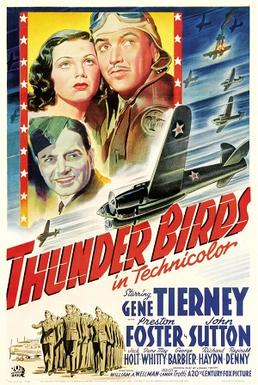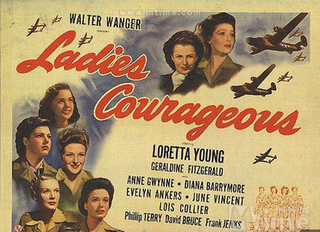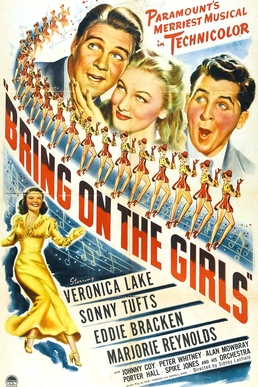
Wings is a 1927 American silent and synchronized sound film known for winning the first Academy Award for Best Picture. Due to the general public's apathy towards silent films, the film was quickly re-released in 1928 with synchronized sound. While the sound version of the film has no audible dialogue, it was released with a synchronized musical score with sound effects.

Test Pilot is a 1938 American drama film directed by Victor Fleming, starring Clark Gable, Myrna Loy and Spencer Tracy, and featuring Lionel Barrymore. The Oscar-nominated film tells the story of a daredevil test pilot (Gable), his wife (Loy), and his best friend (Tracy).

Strategic Air Command is a 1955 American military aviation film starring James Stewart and June Allyson, directed by Anthony Mann, and released by Paramount Pictures. It was the first of four Hollywood films that depicted the role of the Strategic Air Command in the Cold War era.

Constance Frances Marie Ockelman, known professionally as Veronica Lake, was an American film, stage, and television actress. Lake was best known for her femme fatale roles in film noirs with Alan Ladd during the 1940s, her peek-a-boo hairstyle, and films such as Sullivan's Travels (1941) and I Married a Witch (1942). By the late 1940s, Lake's career began to decline, due in part to her alcoholism. She made only one film in the 1950s, but made several guest appearances on television. She returned to the big screen in the film Footsteps in the Snow (1966), but the role failed to revitalize her career.

God Is My Co-Pilot is a 1945 American black-and-white biographical war film from Warner Bros. Pictures, produced by Robert Buckner, directed by Robert Florey, that stars Dennis Morgan and co-stars Dane Clark and Raymond Massey. The screenplay by Abem Finkel and Peter Milne is based on the 1943 autobiography of the same name by Robert Lee Scott Jr.. It recounts Scott's service with the Flying Tigers and the United States Army Air Forces in China and Burma during World War II.

Beirne Lay Jr. was an American writer, aviation writer, Hollywood screenwriter, and combat veteran of World War II with the U.S. Army Air Forces. He is best known for his collaboration with Sy Bartlett in authoring the novel Twelve O'Clock High and adapting it into a major film.

Air Force is a 1943 American World War II aviation film directed by Howard Hawks and starring John Garfield, John Ridgely, Gig Young, Arthur Kennedy, and Harry Carey. The film was distributed by Warner Bros. and produced by Hal B. Wallis and Jack L. Warner. Conceived by then - Lieutenant General “Hap” Arnold in the aftermath of the Pearl Harbor attack, it was originally scheduled for release on December 7, 1942, on the first anniversary. It became impossible to meet that deadline, and it premiered in New York City on February 3, 1943 and was released on March 20. The film's storyline revolves around an actual event that occurred on December 7, 1941. An aircrew ferries an unarmed 1940 series Boeing B-17D Flying Fortress heavy bomber, named the Mary-Ann, across the Pacific to the United States Army Air Forces base at Hickam Field. They fly right into the middle of the Japanese air attack on Pearl Harbor and the beginning of America's major involvement in the Second World War. An uncredited William Faulkner wrote the emotional deathbed scene for Ridgely, who played the commander and pilot of the Mary-Ann.

A Guy Named Joe is a 1943 American supernatural romantic drama film directed by Victor Fleming. The film was produced by Everett Riskin, and starred Spencer Tracy, Irene Dunne, and Van Johnson. The screenplay, written by Dalton Trumbo and Frederick Hazlitt Brennan, was adapted from a story by Chandler Sprague and David Boehm, for which they were nominated for an Academy Award for Best Writing, Original Story.

Beyond the Line of Duty is a 1942 American short propaganda film, directed by Lewis Seiler. The documentary film reenacted the life and career of United States Army Air Corps Captain Hewitt T. "Shorty" Wheless.

Aerial Gunner is a 1943 American black-and-white World War II propaganda film produced by William C. Thomas and William H. Pine, who also directed. The film stars Chester Morris, Richard Arlen, and Jimmy Lydon. This was the first feature film directed by Pine, who produced other films through his company, Pine-Thomas Productions. Aerial Gunner was distributed by Paramount Pictures.

Thunder Birds is a 1942 Technicolor film directed by William A. Wellman and starring Gene Tierney, Preston Foster, and John Sutton. It features aerial photography and location filming at an actual Arizona training base of the United States Army Air Forces named Thunderbird Field No. 1 during World War II.

Bombardier is a 1943 film war drama about the training program for bombardiers of the United States Army Air Forces. The film stars Pat O'Brien and Randolph Scott. Bombardier was nominated for an Oscar in 1944 for the special effects used in the film. It was largely filmed at Kirtland Army Air Field, New Mexico, site of the first bombardier training school.

Dive Bomber is a 1941 American aviation drama film directed by Michael Curtiz, and starring Errol Flynn, Fred MacMurray and Alexis Smith. It was produced and distributed by Warner Brothers. The film is notable for both its Technicolor photography of pre-World War II United States Navy aircraft and as a historical document of the U.S. in 1941. This includes the aircraft carrier USS Enterprise, one of the best-known U.S. warships of World War II.

Flying Blind is a 1941 American action comedy film directed by Frank McDonald and distributed by Paramount Pictures. The film was the second movie from Pine-Thomas Productions. That company's first three films formed an unofficial "aviation trilogy"; all starred Richard Arlen.

The Thousand Plane Raid is a 1969 DeLuxe Color film directed by Boris Sagal and starring Christopher George and Laraine Stephens. Although claimed to be derived from Ralph Barker's The Thousand Plane Raid, the storyline of the film inaccurately portrays the first raid as an 8th Air Force mission while the actual attack was undertaken by 1,047 Royal Air Force bombers against the city of Cologne, Germany in May 1942.

Ladies Courageous is a 1944 war film based on the novel Looking For Trouble (1941) by Virginia Spencer Cowles. Directed by John Rawlins, the film stars Loretta Young and Geraldine Fitzgerald. It tells the story of the paramilitary Women's Auxiliary Ferrying Squadron formed in the United States during World War II. Film historians and scholars consider Ladies Courageous an à-clef story of famed aviator Jacqueline Cochran and test pilot Nancy Harkness Love's work to mobilize women pilots to contribute to the war effort.

Young Eagles is a 1930 American pre-Code romantic drama film directed by William A. Wellman for Paramount Pictures. It stars Charles "Buddy" Rogers, Jean Arthur, and Paul Lukas. The story is based on the stories "The One Who Was Clever" and "Sky-High", written by American aviator and war hero Elliott White Springs. The film's hero is a "heroic combat aviator of the Lafayette Escadrille".

Bring on the Girls is a 1945 American musical comedy film directed by Sidney Lanfield and starring Eddie Bracken, Sonny Tufts and Veronica Lake. It is loosely based on the 1940 French comedy The Man Who Seeks the Truth.
Gilbert O. Wymond Jr. (1919–1949) was a United States Army Air Forces fighter pilot during World War II with service overseas in Africa and Italy campaigns. He was noted for his feature role in the filming of the documentary Thunderbolt (1947).

John Trent was an aviator-turned-actor-turned-aviator, best known as an actor for the "Tailspin Tommy" adventure film series in the 1930s. From 1931 to 1941, under the stage name John Trent, Browne appeared in 16 Hollywood films. While flying was a natural for him, acting was not, and he eventually turned his back on his Hollywood career, resuming his career in aviation, as a test pilot.



















